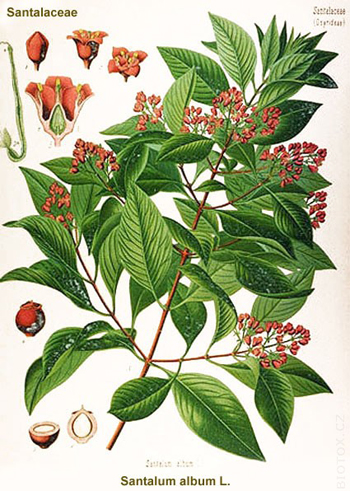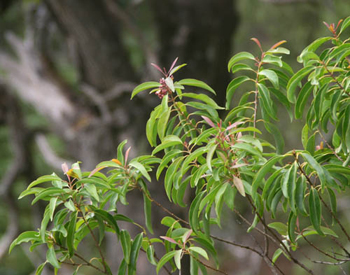Contents:
Common Names | Parts Usually Used | Plant(s) & Culture | Where Found | Medicinal Properties | Biochemical Information
Legends, Myths and Stories | Uses | Formulas or Dosages | Warning | Bibliography
Scientific Names

- Santalum album L.
- Santalaceae
- Sandalwood family
Common Names
- Chandana (Sanskrit name)
- T’an-hsiang (Chinese name)
- White sandalwood
- White saunders
- Yellow sandalwood
Parts Usually Used
The heartwood, volatile oil
Back to Top

Description of Plant(s) and Culture
Sandalwood is a small tree; the wood of its stem, which grows from 20-30 feet tall, is heavy and straight-grained and varies in color from white when young to yellow or orange when older. Its oval leaves are covered with a whitish bloom; its small flowers varying in color, grow in numerous cymes.
Back to Top
Where Found
Grows primarily in India, particularly Malabar, as well as in the Pacific and Malayan Islands.
Back to Top
Medicinal Properties
Alterative, aromatic, analgesic, antibacterial, antidepressant, antiseptic, antispasmodic, astringent, carminative, disinfectant, diuretic, expectorant, hemostatic, refrigerant, sedative, stimulant, stomachic, tonic
Back to Top
Biochemical Information
Volatile oil with at least 90% total alcohols including alpha-santalol and beta-santalol; other constituents include isovaleric aldehyde, santene, santenone, teresantol, santalone, and santalene
Back to Top
Legends, Myths and Stories
Since ancient times in India, Burma, and China, the aromatic sandalwood tree has played an important part in the religious rituals of Hindus and Buddhists, providing them incense, embalming ingredients, and wood for funeral pyres and temples. The Buddhists continue to use it today in their funeral rites and other religious ceremonies. Its oil is a famous and expensive ingredient in perfumes. The age-old process of the harvesting of sandalwood is interesting, because termites play an important role in it. First the trees are cut down or uprooted, and the branches and roots are removed. The remaining tree trunks are left on the ground for several months so that termites can eat away the worthless outer layer of sapwood, exposing the fragrant heartwood, the only commercially usable part of the tree.
The burning of incense has from the earliest ages been intimately connected with the religious sentiments of man; being practiced by Pagan, Jew and Christian. In the Catholic churches, various kinds of aromatic gum-resins are used, while in Pagan temples sandalwood holds the highest rank, pieces of the wood, varying in size according to circumstances, being burned before images of their deities, and the millions of Brahmins and Buddhists, on beholding the smoke of the incense curling heavenward, presume they have performed their religious duties and that the perfume smelled by their deity will obtain forgiveness of sins.
Piesse wrote in 1857 that sandalwood grew plentifully in China, but the continued offerings of the Buddhists have almost exterminated the tree. In Chinese temples joss sticks (candles) made of sawdust of sandalwood are kept burning before their idols.
The Moslems of India in all their religious ceremonies burn an incense made of sandalwood, aloe, patchouli and gum benzoin. In Hindu temples, the Du, or god, is, before the services, anointed with oil of sandalwood or the sawdust of the wood in water. In an Indian religious fete, devotees anoint themselves with an ointment made with powdered tumeric root and grease, to go about collecting alms in return for which they distributed scented candles made with sandalwood, which are received with great veneration.
No Oriental type perfume composition is considered complete unless it contains a good proportion of sandalwood oil. Its powerfully sweet and long lasting odor makes it an excellent fixative for potpourri and sachet mixtures. Sandalwood oil is used also for making violet, cassia and similar perfumes. It was formerly much used to adulterate oil of roses. In the Far East sandalwood is used to make curious boxes, for which it is valued, as no insect can exist nor iron rust, within its influence.
Sandalwood is mentioned often in Marco Polo’s 13th century narrative.
Back to Top
Uses
The medical properties reside in the oil, which can be pressed from the wood or extracted with alcohol or water. The antiseptic and disinfectant properties of the oil are similar to those of cubeb oil. The oil is used for bronchitis and for inflammation and infections in mucous tissue. A decoction of the wood may be helpful for indigestion, nephritis, gall stones, gonorrhea, sunstroke, prostatitis, urinary antiseptic for cystitis, urethritis, vaginitis, and fever; externally, for acute dermatitis, herpes zoster, skin problems, especially those of bacterial origin.
The Herbalist Almanac states: “A few drops of oil of sandalwood, dropped onto a hot plate, will be found to diffuse a most agreeable balsamic perfume throughout the atmosphere of sick rooms, or other confined apartments.” Unpleasant odors of sick rooms, often difficult to erase, has been noted in cases of extensive burns, last stages of cancer, vomitus odors, etc.
Back to Top
Formulas or Dosages
Decoction: boil 1 heaping tsp. wood in 1 cup water. Take 1 to 2 cups a day, a mouthful at a time.
Tincture: a dose is from 20 to 40 drops.
The Sandalwood Incense Recipe:
Charcoal 1 1/2 lb.; salt petre 3 1/2 oz.; gum benzoin 1/2 lb.; sandalwood 5 1/2 oz; Tolu balsam 2 3/4 oz.
To make pastilles: mix the above powdered ingredients thoroughly. Add enough mucilage of Gum Arabic to form plastic mass. Best results obtained when kneaded with a pestle. Form cones in desired size and allow to dry.
Back to Top
Warning
Caution should be taken in severe lung congestion. Medical supervision is recommended.
Back to Top
Bibliography
![]() American Folk Medicine
American Folk Medicine, by Clarence Meyer, Meyerbooks, publisher, PO Box 427, Glenwood, Illinois 60425, 1973
![]() The Complete Medicinal Herbal
The Complete Medicinal Herbal, by Penelope Ody, Dorling Kindersley, Inc, 232 Madison Avenue, New York, NY 10016, First American Edition, copyright 1993
![]() Chinese Medicinal Herbs
Chinese Medicinal Herbs, compiled by Shih-Chen Li, Georgetown Press, San Francisco, California, 1973.
![]() The Herbalist Almanac
The Herbalist Almanac, by Clarence Meyer, Meyerbooks, publisher, PO Box 427, Glenwood, Illinois 60425, copyright 1988, fifth printing, 1994
![]() The Herb Book
The Herb Book, by John Lust, Bantam Books, 666 Fifth Avenue, New York, NY. copyright 1974.
![]() Indian Herbalogy of North America
Indian Herbalogy of North America, by Alma R. Hutchens, Shambala Publications, Inc., Horticultural Hall, 300 Massachusetts Avenue, Boston, Massachusetts 02115, 1973
![]() Indian Uses of Native Plants
Indian Uses of Native Plants, by Edith Van Allen Murphey, Meyerbooks, publisher, PO Box 427, Glenwood, Illinois 60425, copyright 1958, print 1990
 Old Ways Rediscovered
Old Ways Rediscovered, by Clarence Meyer, Meyerbooks, publisher, PO Box 427, Glenwood, Illinois 60425, published from 1954, print 1988
![]() Planetary Herbology
Planetary Herbology, by Michael Tierra, C.A., N.D., O.M.D., Lotus Press, PO Box 325, Twin Lakes. WI 53181., Copyright 1988, published 1992
![]() The Yoga of Herbs: An Ayurvedic Guide to Herbal Medicine
The Yoga of Herbs: An Ayurvedic Guide to Herbal Medicine, by Dr. David Frawley & Dr. Vasant Lad, Lotus Press, Twin Lakes, Wisconsin, Second edition, 1988.
![]() Webster’s New World Dictionary
Webster’s New World Dictionary, Third College Edition, Victoria Neufeldt, Editor in Chief, New World Dictionaries: A Division of Simon & Schuster, Inc., 15 Columbus Circle, New York, NY 10023
